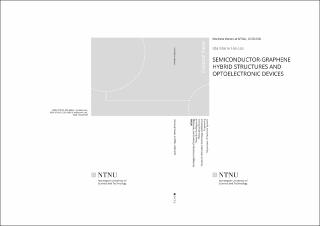| dc.contributor.advisor | Weman, Helge | |
| dc.contributor.author | Høiaas, Ida Marie | |
| dc.date.accessioned | 2020-09-02T13:05:47Z | |
| dc.date.available | 2020-09-02T13:05:47Z | |
| dc.date.issued | 2020 | |
| dc.identifier.isbn | 978-82-326-4865-8 | |
| dc.identifier.issn | 1503-8181 | |
| dc.identifier.uri | https://hdl.handle.net/11250/2676092 | |
| dc.description.abstract | In order to utilise the intriguing properties discovered in nanomaterials during the last decades, structures and devices that do exactly that have to be developed. Graphene, the carbon wondermaterial discovered in 2004, has baffled the scientific community with its endless possibilites for quantum physics experiments, as well as extreme properties for current conduction, transparency and heat dissipation. Semiconductor nanowires with their one-dimensionality have been able to solve some fundamental challenges in thin films, as they enable the integration of optically active semiconductors onto both conventional and new substrates. Together with a precise control of crystal design, this enables the integration of lasers, solar cells, photodetectors and light emitting diodes with different substrates not suitable for bulk growth. To take advantage of the possibilities offered by combining these two very different nanostructures, complex fabrication strategies, diligent and multifaceted characterisation work and extensive collaborations have to be employed to reach the end-goal of actual functional devices.
We have studied several approaches to enable the fabrication of graphenesemiconductor hybrid devices. The transfer of graphene with a metal protection layer has been studied in detail to try and realise molecular beam epitaxycompatible chemical vapour deposited graphene for the direct growth of semiconductor nanowires. The growth of GaAs, GaAsSb and GaN nanowires on kish graphite has been investigated both with and without an oxide mask for position-controlled growth of the nanowires. A two-layer mask structure consisting of alumina and silicon oxide was found to give the best selectivity, while the oxygen plasma and subsequent hydrogen annealing treatment of graphite was found to increase the nucleation probability of nanowires.
To further increase the nucleation probability of GaAs and GaAsSb nanowires on chemical vapour deposited graphene, a thin film consisting of aluminium-induced crystallised Si was deposited. By varying the silicon surface oxide formation and optimising the nanowire growth, high-density vertical nanowires could be grown. Not only did the thin film of polycrystalline Si strongly increase the density of vertical nanowires, it was also discovered that the presence of graphene directly affected the crystallinity of the aluminium-induced crystallised Si, when compared with the same substrate without the graphene layer. The deposited Si had an increase in (111)-oriented grains with respect to the surface plane, which is beneficial for the growth of vertical GaAs nanowires, which also grow in the [111]-direction. The graphene is not damaged as aluminium-induced crystallisation of Si takes place at relatively low temperatures (< 577 C), and apparently adopts the strain present in the polycrystalline Si. An epitaxial model is suggested to explain the effect of graphene on Si crystallisation. A photodetector consisting of the graphene and aluminium-induced silicon was fabricated, but as of yet reliable operation could not be achieved.
The growth of GaN/AlGaN nanowires on bi- and single-layer graphene was studied and used for the fabrication of ultraviolet light emitting diodes using graphene as a transparent conductive electrode. The nitrogen plasma extensively damages graphene, but through the use of a special nucleation scheme using an AlN buffer layer the damage can be decreased and graphene can inject current through the photoactive nanowires. Emission in the UVA region (365 and 352 nm) was achieved, and the simultaneous use of graphene as growth substrate and transparent conductive electrode was demonstrated for the first time for any device.
Together, this work demonstrates the possibilities and potential platforms of certain semiconductor-graphene optoelectronic devices, possibly enabling the development of commercial technology in the future. | en_US |
| dc.language.iso | eng | en_US |
| dc.publisher | NTNU | en_US |
| dc.relation.ispartofseries | Doctoral theses at NTNU;2020:258 | |
| dc.relation.haspart | Paper 1: Høiaas, Ida Marie; KIM, DONG CHUL; Weman, Helge. Fabrication of Si(111) crystalline thin film on graphene by aluminum-induced crystallization. Applied Physics Letters 2016 ;Volum 108.
https://doi.org/10.1063/1.4947101
This article is licensed under a Creative Commons Attribution (CC BY) license (http://creativecommons.org/licenses/by/4.0/). | en_US |
| dc.relation.haspart | Paper 2: Ren, Dingding; Høiaas, Ida Marie; Reinertsen, Johannes F; Dasa Lakshmi Narayana, Dheeraj; Munshi, Abdul Mazid; KIM, DONG CHUL; Weman, Helge; Fimland, Bjørn-Ove.
Growth optimization for self-catalyzed GaAs-based nanowires on metal-induced crystallized amorphous substrate.
Journal of Vacuum Science and Technology B:Nanotechnology and Microelectronics 2016 ;Volum 34.(2)
http://dx.doi.org/10.1116/1.4943926
© 2016 American Vacuum Society | en_US |
| dc.relation.haspart | Paper 3: Andreas Liudi Mulyo, Anjan Mukherjee, Ida Marie Høiaas, Lyubomir Ahtapodov, Tron Arne Nilsen, Håvard Hem Toftevaag, Per Erik Vullum, Katsumi Kishino, Helge Weman and Bjørn-Ove Fimland.
Graphene as Transparent Conducting Substrate for The Fabrication of Flip-chip Ultraviolet Light-Emitting Diode Based on GaN/AlGaN Nanocolumns. | en_US |
| dc.relation.haspart | Paper 4: Høiaas, Ida Marie; Liudi Mulyo, Andreas; Vullum, Per Erik; Kim, Dong Chul; Ahtapodov, Lyubomir; Fimland, Bjørn-Ove; Kishino, Katsumi; Weman, Helge.
GaN/AlGaN nanocolumn ultraviolet light-emitting diode using double-Layer graphene as substrate and transparent electrode. Nano letters 2019 ;Volum 19.(3) s. 1649-1658
https://doi.org/10.1021/acs.nanolett.8b04607 | en_US |
| dc.title | Semiconductor-graphene hybrid structures and optoelectronic devices | en_US |
| dc.type | Doctoral thesis | en_US |
| dc.subject.nsi | VDP::Technology: 500::Electrotechnical disciplines: 540::Electronics: 541 | en_US |

